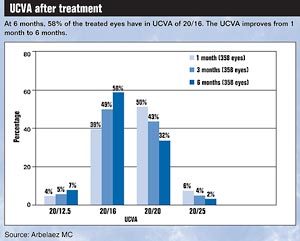Latest-generation excimer laser setting new standard in refractive treatments
Six-month results with the Amaris show a high degree of safety, efficacy and predictability.
BARCELONA – The new Schwind Amaris excimer laser platform produces LASIK treatments of high quality in terms of visual outcomes, smooth surfaces, no induced high-order aberrations and higher contrast sensitivity, according to the results of a multicenter study presented.
The purpose of this ongoing prospective study, according to Maria Clara Arbelaez, MD, of the Muscat Laser Eye Center in Oman, is to evaluate the outcomes of the Amaris in performing LASIK aberration-free treatments for myopic astigmatism. The investigators are distributed in seven centers worldwide.
 Maria C. Arbelaez |
“This new platform is a unique combination of all available state-of-the art technologies: the Optikon Keratron Scout topographer, the Schwind Ocular Wavefront Analyzer, CAM software, Carriazo-Pendular microkeratome and the Amaris excimer laser,” Dr. Arbelaez said at the European Society of Cataract and Refractive Surgeons Winter Refractive Surgery meeting.
The Amaris, she said, is “a super-fast laser” with a 500-Hz repetition rate, a minimum spot size of 0.54 mm (full width at half maximum) and super-Gaussian beam profile that ensures high ablation accuracy and smooth surfaces at a high ablation speed.
The automatic fluence level adjustment and intelligent thermal effect control improve accuracy and safety throughout the treatment.
Another development is the five-dimensional 1,050 Hz turbo eye tracker with a rotation balance system, which compensates for horizontal and vertical displacement, horizontal and vertical rotation, and cyclotorsion. Tracking points on the limbus and sclera, in addition to the iris, ensure centration and compensation for pupil center shifts.
Impressive outcomes
The results of 358 eyes that reached 6 months of follow-up in the multicenter study seem promising, Dr. Arbelaez said.
 |
The age of the patients ranged between 18 and 60 years (a mean of 28 years), the preoperative myopic range was up to –7 D and cylinder was up to –5 D.
At 6 months, the mean spherical equivalent was –0.12 D, with a standard deviation of ±0.2 D, ranging from –0.75 D to +1 D. Mean cylinder was –0.17 D, with a similar standard deviation and a range between –1.25 and 0 D.
Dr. Arbelaez said predictability was high. All eyes were within ±1 D of intended myopic correction without any re-treatment, and most eyes were within ±0.5 D. A comparable level of accuracy was found for the astigmatic component.
“If we look at the overall refractive outcomes, we can observe that 73% of the eyes were within ±0.25 D, 96% within ±0.5 D and 100% within ±1 D,” Dr. Arbelaez said.
Refraction was stable from the first week to 6 months follow-up.
Results in terms of visual acuity were also impressive, she said. More than 55% of the eyes showed best corrected visual acuity improvement, gaining one or more lines.
“These results are due to the low induction of aberrations obtained with the Amaris ‘aberration-free’ Schwind-CAM profile,” Dr. Arbelaez said. “At 6 months, 98% of the eyes achieved a UCVA of 20/20 or better, while preoperatively only 92% were 20/20 or better best corrected.”
An UCVA of 20/16 was achieved in 58% of the eyes, with a steady improvement from 1 to 6 months.
|
Aberration-free LASIK
The Amaris system allows refractive surgeons to choose between aberration-free treatments that make no change over the preoperative higher-order optical aberrations, ocular wavefront-guided procedures that reduce overall aberrations and topography wavefront-guided procedures that address corneal aberrations.
Wavefront analysis showed that the aberration-free approach used in the multicenter study kept its promise, preserving preoperative aberrations.
“Indeed, LASIK becomes a safe procedure, with a negligible amount of induced aberrations. In the eyes we have so far analyzed, mean spherical aberration changed from preop 0.3 to 0.36, coma increased from 0.27 to 0.29 and [higher-order aberrations] from 0.47 to 0.54. In all three cases, standard deviation was low,” Dr. Arbelaez said.
“As the study goes on, more reliable conclusions will be drawn about this new laser. However, at 6 months, we can say that the Amaris provides excellent, safe and predictable outcomes, with a fast recovery time, no surprises and high satisfaction for both the surgeon and the patient,” she said.
In her practice in Oman, Dr. Arbelaez has already performed more than 1,500 consecutive cases with the new Schwind Amaris and said her results are “more than amazing so far.”
“Previously, our re-treatment rate was between 1.5% and 2%. Now I can see it is going to be far lower,” she said.
For more information:
- Maria Clara Arbelaez, MD, can be reached at Muscat Eye Laser Center, Way 3013, House 877, Al Sarooj St., Shatti Al Qurm, P.O. Box 938, Wadi Al Kabir, P.C. 117, Muscat, Sultanate of Oman; +968-24691414; e-mail: drmaria@omantel.net.om. Dr. Arbelaez has no direct financial interest in the products discussed in this article, nor is she a paid consultant for any companies mentioned.
- Schwind eye-tech-solutions, maker of the Amaris system, can be reached at Mainparkstrasse 6-10, 63801 Kleinostheim, Germany; +49-6027-508-0; fax: +49-6027-508-208; Web site: www.eye-tech-solutions.com.
- Michela Cimberle is an OSN Correspondent based in Treviso, Italy, who covers all aspects of ophthalmology. She focuses geographically on Europe.
